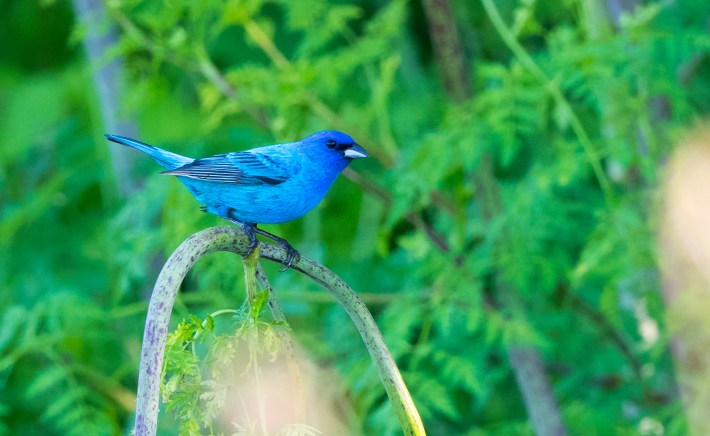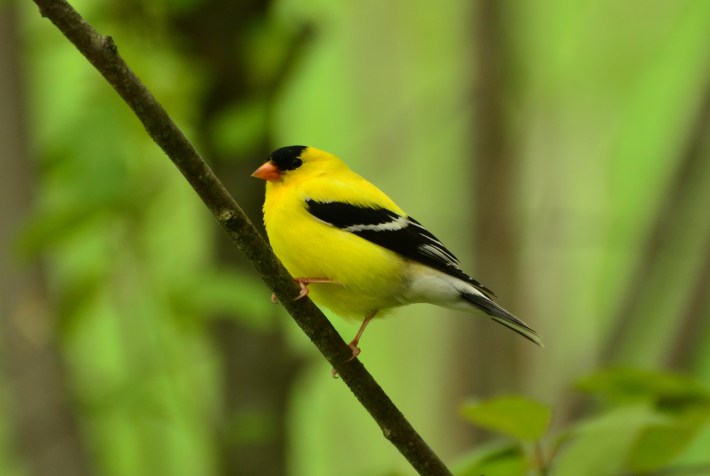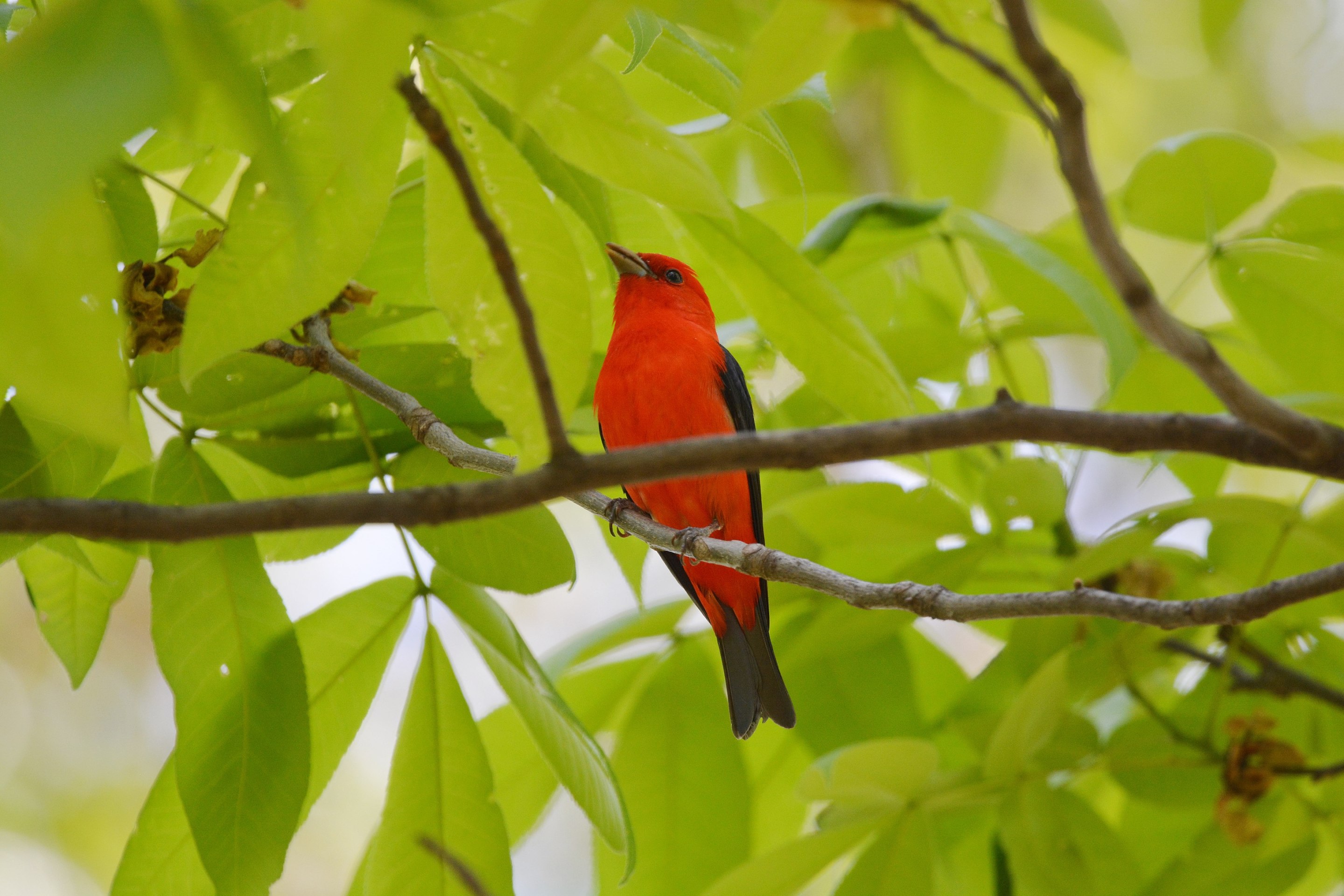Yesterday I walked out onto my front porch and there, right over there, bopping around on the ground underneath a bird feeder, was a male Indigo Bunting. Indigo Buntings spend their winters in sunny Central America, and throughout the Caribbean. Toward the end of winter they start migrating north, by moonlight and via celestial navigation, into their breeding grounds, which extend from Florida all the way up into Maine and southern Canada. Indigo Buntings arrive in my particular neck of the woods toward the end of April, and settle in for a long summer of nesting and smooching and rearing hatchlings. It has been an ambition of mine for several years to court some mating pairs of Indigo Buntings to my yard, so that I can stare at them all the time, because they are beautiful. Unfortunately, I do not feel super confident that yesterday's Indigo Bunting will stick around: When I saw him, I made a loud screeching sound, pointed at him, and went "DAH! BAH! BAH! AAAAAHHHHHH!" and he freaked out and flew away and did not return.
I pity the fools who live in the sunny and tropical and beautiful places where Indigo Buntings spend their winters, and here is why: Male Indigo Buntings, in the winter, are a drab grayish blue color. It is only once they've arrived in their nesting territory and spruced themselves up for some hot bird action that they achieve their perfect, shockingly vibrant cerulean blue color with a dark indigo head. You simply cannot lay eyes on a male Indigo Bunting during the summer and not gasp. They are incredibly beautiful creatures. If I were a fellow Indigo Bunting, I would have bird sex with one thousand of them.

Two important things are happening for those of us who live in the northern hemisphere. First, migratory birds are returning to their nesting grounds for the summer. These ranges can be anywhere from the deep south all the way up to arctic Canada. Those little Dark-Eyed Juncos who were congregating adorably under your seed-feeders on snowy winter days do all their their breeding up in Canada. Almost no one who has ever spoken to me in person has not heard me rant about the Stilt Sandpiper, which if you have ever visited a beach along the east coast of America you have seen darting along the surf. Every time you have ever seen one of them, it has been in the middle of an incredible journey between its winter turf, in South America, and its breeding ground, on the narrow band of terrifyingly remote and inhospitable gravel islands that form the northernmost reaches of land on the planet. But the majority of migratory birds of the western hemisphere spend their summers somewhere in the habitable parts of the U.S. and Canada, where you and I can greet them with a wave and a smile.
The other important thing that is happening, as happens with those gorgeous male Indigo Buntings, is the colorful birds are getting super-duper extremely colorful. Male American Goldfinches, which are migratory but spend the whole year in broad areas of North America, go from pea soup-colored in the winter to the absolute most bitchin' racer yellow color in the summer. Tree Swallows go a shocking aquamarine. Vireos and many Warblers go various striking shades of gold and yellow. Scarlet Tanagers brighten up into a gaudy red-orange. Blue Grosbeaks go a dignified royal blue. The bellies of Baltimore Orioles turn tangerine. Don't even get me started on the Northern Parula. I think if I saw one of these beauties in the wild I would simply explode:

Not all the color transformations are as complete as that of the American Goldfinch, but every bird that is colorful is noticeably more colorful when the time comes for courtship and mating. Just as you or I shower and put on our nice clothing and comb our hair or whatever in order to appear healthy and attractive for a change, so do our bird pals glam up in order to make an impression on prospective mates. They even do a lot more singing! This means that in addition to a more active and abundant ecosystem, we also get a lot of lovely and energetic and easily identifiable little pals to watch in the trees and in the shrubs and grasses. Soon all this showing off will lead to mating, and then to nesting, and then to the rearing of young, and though the activity will continue into the super-hot summer months, the watching will be somewhat less exciting. Right now, today, this very weekend, this is the primo time for watching birds.

Today I grabbed a pair of binoculars and walked outside and went on an hour-long hunt for Great Crested Flycatchers, who will arrive in their largest numbers of the year over the next two weeks. These impressive mohawked suckers winter with the Indigo Buntings in Central America and do their breeding in a somewhat narrower band of the eastern half of the U.S. and Canada. They're somewhat more elusive—they prefer deciduous forests and mixed woodlands, and they nest up high, and from a distance they can be confused with Eastern Phoebes and other, smaller flycatchers—but adult males and females both have extremely cool neon yellow chests and bellies, making them easily identifiable if you can just get a decent view of them. I did not spot any of them on my expedition, but I know they're around, and by God I will find them.
What I am saying to you today is you should get out there and find the birds! The time is now! Don't miss the best time of the entire year!







